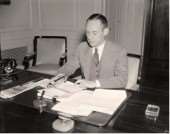 A new staff report prepared for the Federal Reserve Bank of New York discusses the prospect of the direct purchase of U.S. Treasury securities by the Federal Reserve banks.
A new staff report prepared for the Federal Reserve Bank of New York discusses the prospect of the direct purchase of U.S. Treasury securities by the Federal Reserve banks.
The customary way in which the Fed goes about expanding the money supply (or “easing” it “quantitatively,” if you prefer) is through the purchase of bonds from private parties in the market. This has been the case consistently since 1981, yet some have questioned the wisdom of that strategy. It sounds uneasily like “crony capitalism,” a bit of deliberate favoritism. After all, wherever the Fed buys its bonds with its newly created money, there you have the first beneficiaries of the easing. The money is supposed to spread out from those points to the economy as a whole.
Former Fed chairman Ben Bernanke used to talk hypothetically of a “helicopter drop,” which might be a more fair way to get the new money equitably distributed. But it sounds as if it would be awkward to implement. How about a policy in which the Fed buys bonds directly from the Treasury?
Direct purchase has its own history, one that is almost as old as the Federal Reserve itself. The new staff report is devoted to setting this out, and it does a fine job; but a summary here is in order for those of our readers pressed for time.
Taking it From the Top
In late March, 1917, with the U.S. on the verge of entering the Great War, the Treasury Secretary (William McAdoo) requested that the Fed purchase Treasury securities (“certificates” with a 2% interest rate, which was below the market rate) and that it do so directly.
The Fed’s bigwigs weren’t happy about this. The Governor of the Boston FRB lectured the Treasury that in the future it should sell its bonds to the commercial banks (“at a rate that will induce the commercial banks to absorb the issue” – that is, at a higher rate than this chintzy 2%) rather than again ask the Fed’s member banks to “take the issue direct.”
In 1935, Congress amended the law to prohibit any further direct Treasury-to-Fed bond sales. But in 1942 – note the date, and the importance of wartime in the history of public finance generally – Congress relaxed this prohibition significantly. Congress said that the FRBs can directly acquire and hold up to but no more than $5 billion from the U.S.
After the war, with the threat of national insolvency it had raised now vanishing into memory, Congress deliberated and decided against reverting to the 1935-1942 prohibition. Instead, it extended permission for direct borrowing thereafter from time to time (always in the form of temporary measures) for decades.
Lobbying of Bond Dealers
In 1947, Mariner Stoddard Eccles, the Federal Reserve chair, said that Congress’ 1935 prohibition of the practice was likely due to the lobbying of bond dealers. Of course, he was diplomatic about this. The bond dealers “quite naturally had their eyes on business that might be lost to them if direct purchasing were permitted.”
That does sound natural, but the staff report rather half-heartedly declares this idea, that “dealer resistance to direct purchases” was behind the 1935 law, “unlikely.”
Yet if Eccles was right, then perhaps bond dealers had acquired a new level of pull by 1979, analogous to what they had been able to achieve for themselves in 1935! It was in 1979 that Congress for the last time renewed the direct-purchase authority with the $5 billion limit. But it didn’t use the old 1942 language. Instead, the 1979 bill said that direct purchases would require the affirmative vote of no fewer than five members of the FRB and that they would be warranted only in case of “unusual and exigent circumstances.”
This final permission was allowed to expire in 1981, and the old 1935 prohibition on such arrangements has been in place ever since.
What strikes me, reading this report, is that through the decades while the direct-versus-indirect issue was repeatedly debated by Congress, for more than four decades beginning in 1935, there seems to have been almost no discussion of whether direct or indirect lending to the Treasury was the best practice for the Fed, for the sake of its purposes. No … the discussion during that whole period seems to have been: what is best for the Treasury, for its cash management purposes. It was always a fiscal-policy-driven debate, not a monetary-policy debate.
Isn’t it about time to have the monetary policy debate? Or, we can wait until fighting ISIS or some other foe or alliance of foes brings us back to the financial situation of 1917 or 1942, and try debating it calmly then.



